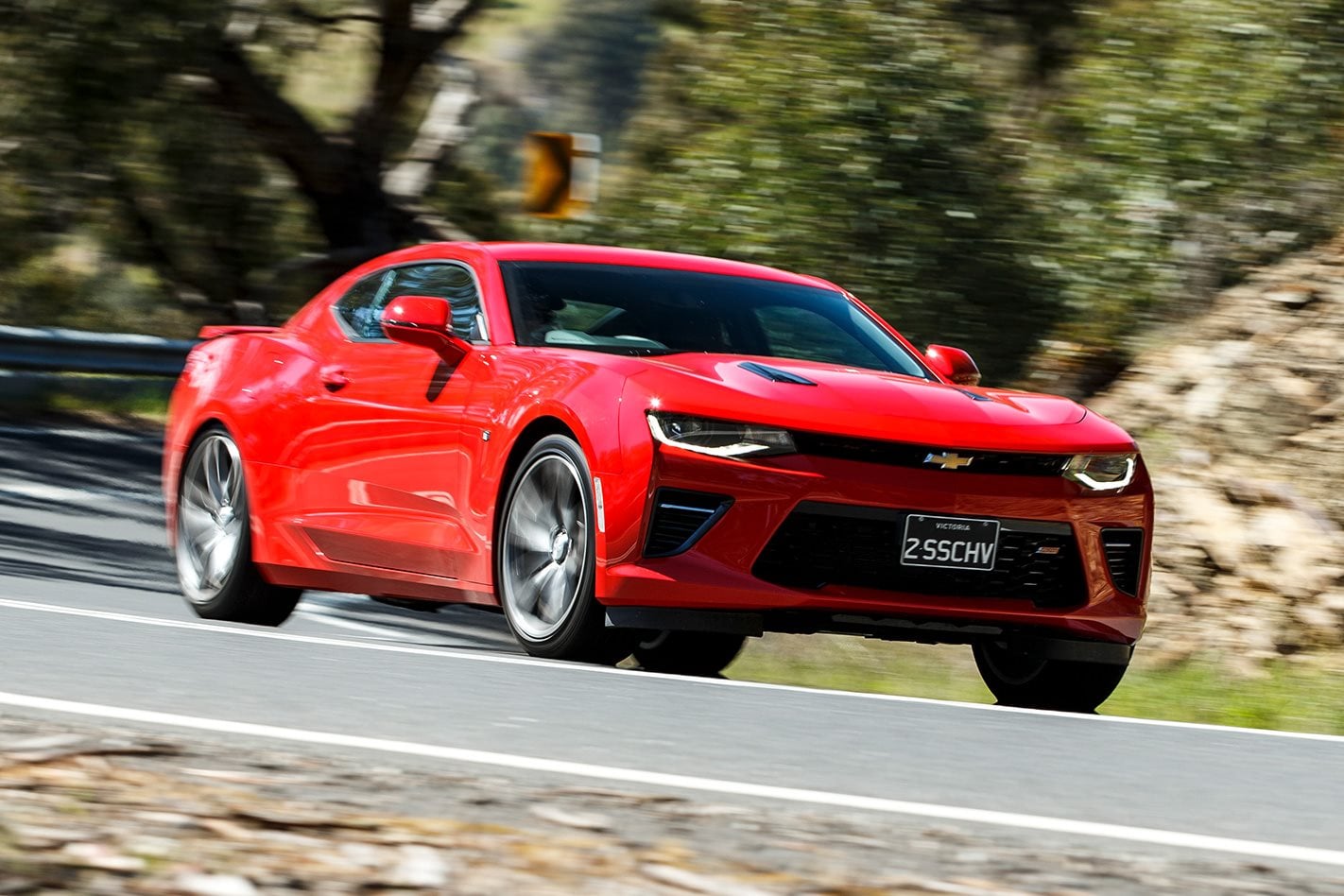THE tangle of thoughts and emotions are separated by nearly 37 years; well beyond the span of boy to man. Yet they all riff on the same theme: wide-eyed lust and wonder, a frisson of excitement, a jangle of nervy anticipation. They go a fair way to proving the old adage often touted by women: as blokes, we really are 15 until we die.
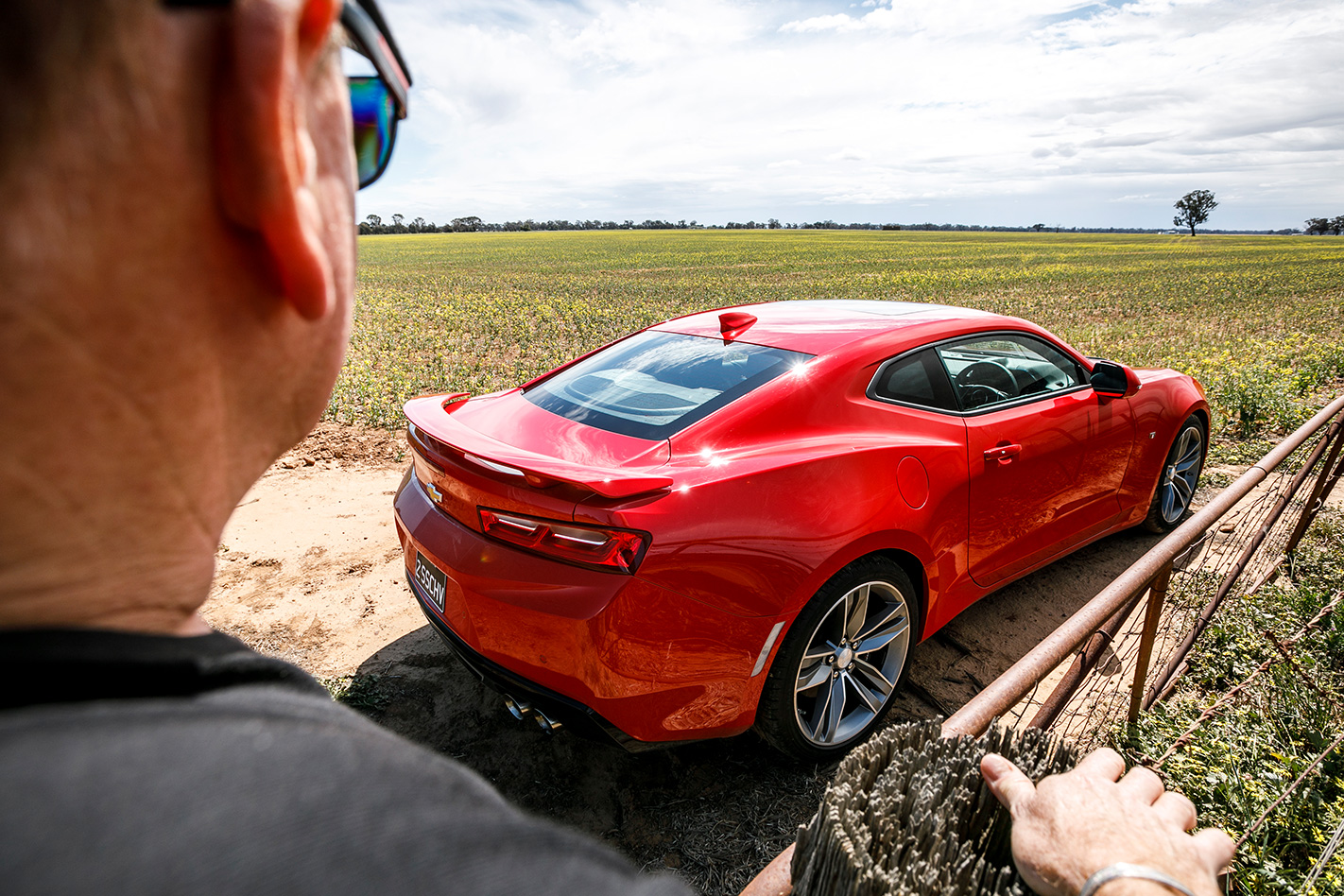
Actually, I was 16 when I first saw the Group C Z28 Camaro driven by Kevin Bartlett and Colin Bond at Bathurst in 1982. It was my first trip to the Mountain and I was in pimply, teenage awe of the Camaro’s bulging haunches and head-kicker stance. To me, it looked a size bigger and serious lash tougher than the Aussie touring cars of the period. Standing at the wall at Reid Park, watching Bartlett belting it over the top of the mountain, the car heaving on its springs and flooding the camping area with Chevy V8 thunder, my heart pulled what felt like 7500bpm in my chest.
And now here I am, a half-century on the Westerman odo, and a very different, but still completely identifiable Camaro is generating similar feelings. This one has arguably a tougher role to fill than towelling up VH Commodores and XE Falcons while shooting for a Bathurst win. This HSV-converted import has to generate some tribal loyalism for the Chev bow-tie and make Aussie Holden fans want to pin it to their collective chest. At the very least, it needs to provide a visual lure into the newly branded Chevrolet section in Holden showrooms where kids, in tow with mum and dad, can stare and dream.
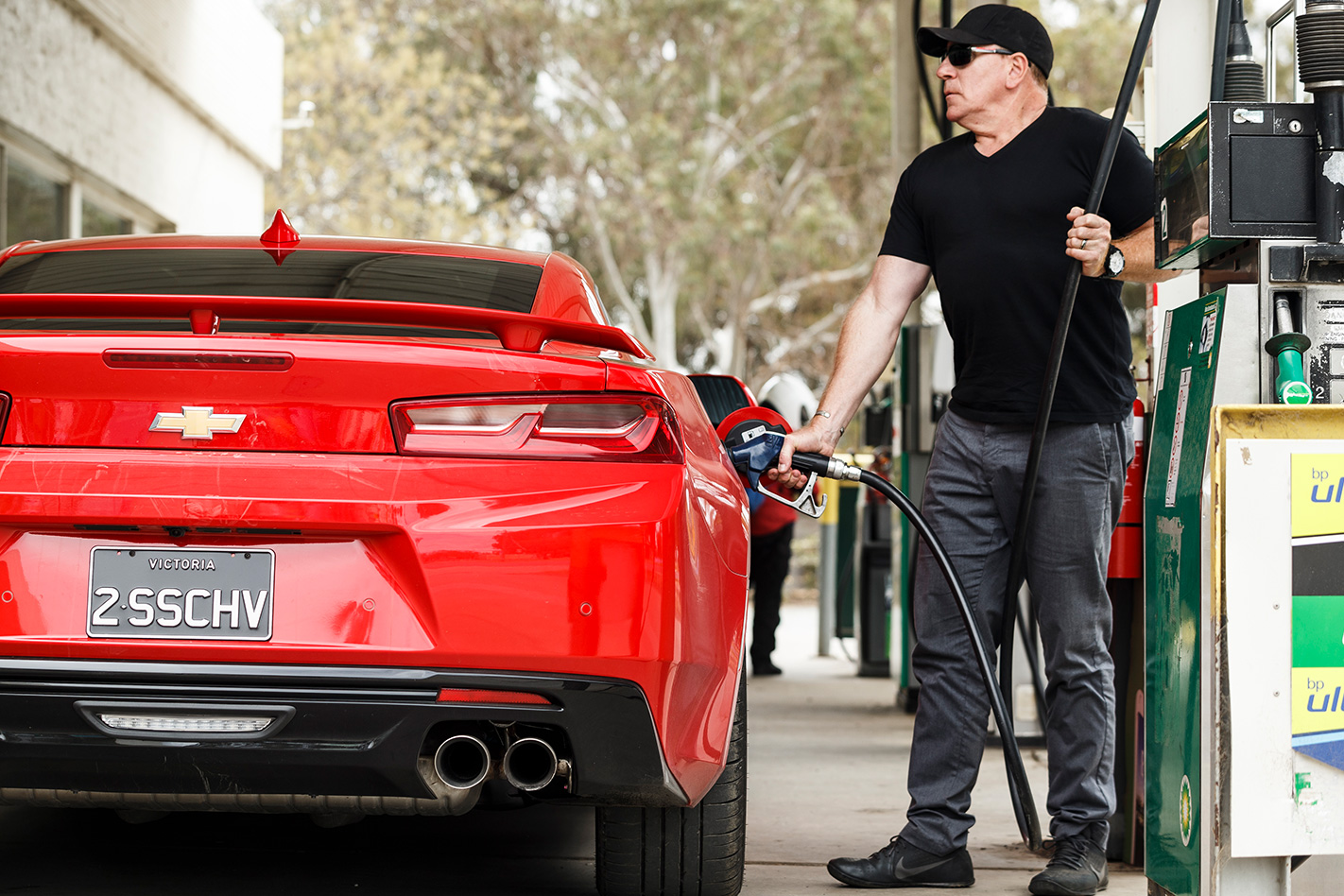
No question it has the styling firepower. For me, there’s a level of visual menace that tops even the mightily annoyed-looking Mustang. The front end reminds me of a law-evading gang-banger with baller cap pulled down low over its brow; bandana pulled up to hide its nose and mouth, leaving just those slitty, threatening eyes. You don’t know if it wants to mug you or challenge you to a rap battle.
As snapper Jacobs and I pull away from the kerb, I realise I was right the first time: it does want to mug you. At least, the suspension tune wants to let you know who’s boss. It’s abrupt over small stuff, and has a serious aversion to ruts and sharp edges. The whopper Goodyear F1 tyres are run-flats; could they be contributors to the lack of low-speed bump absorption? And what’s with the steering weight?We’re in the most relaxed of the drive modes, ‘Touring’, yet the steering feels unnecessarily chunky, and the self-centring action feels kinda glutinous and not particularly natural.
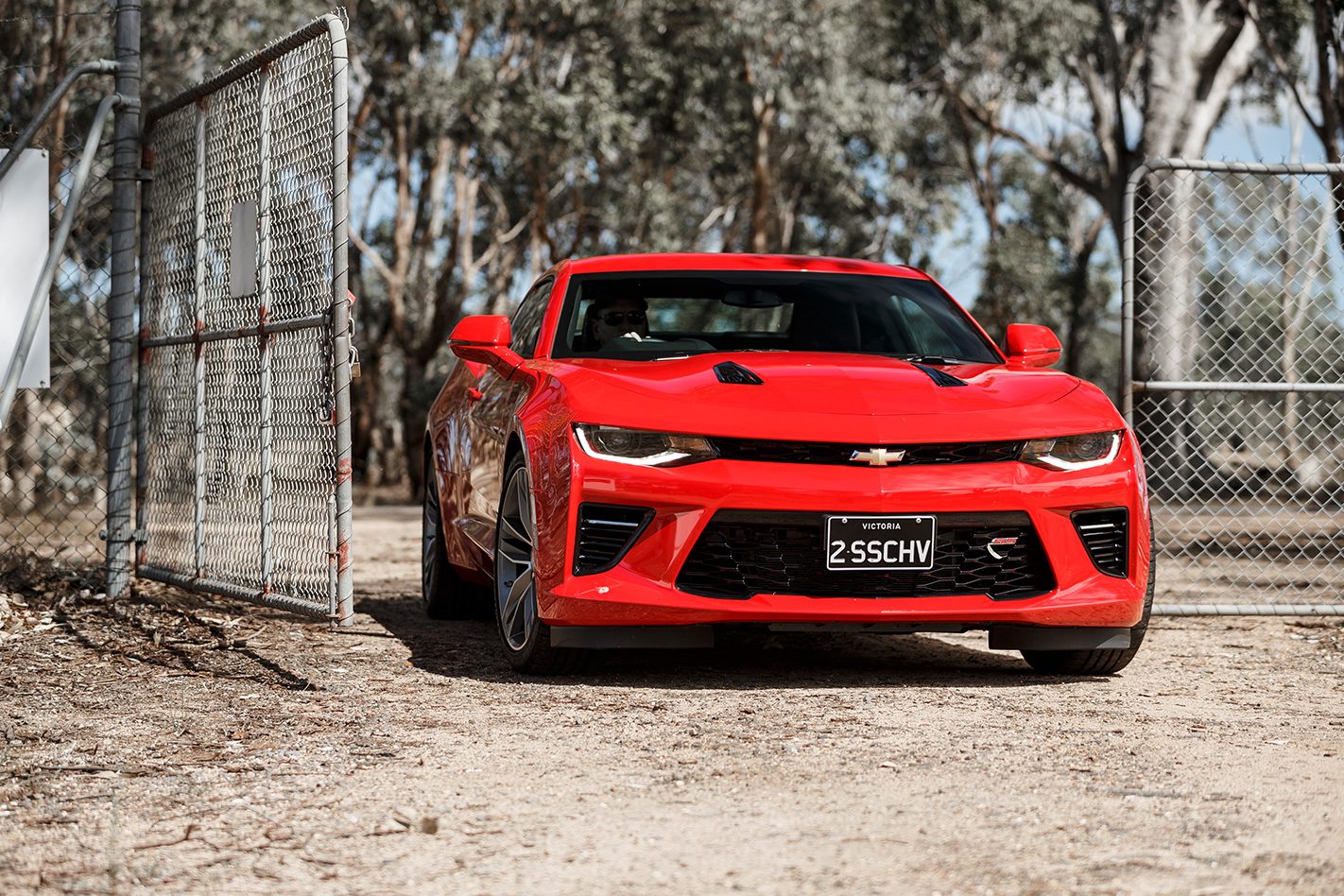
As we ease onto the highway and head towards the Heathcote dragstrip, there’s a chance to appreciate the crisp response of the new-for-Oz LT1 V8 (see sidebar p75), and revel in the baritone sonics of engine and exhaust. The eight-speed auto feels properly in tune with your right foot and intentions in easy driving. As we settle into a cruise, and the revs drop to just 1500rpm at the 110km/h limit, the exhaust note becomes a distant, almost hypnotic rhythm, and tyre noise on coarse-chip becomes the dominate sound in the cabin. At times it feels like someone’s pulled the antenna out of an old analogue television, and turned up the sound of the white-noise static. When it abates for brief periods on hot mix, there’s the sound of chipmunk chatter from the dash section above the instrument panel. Maybe it’s time to start revising my expectations, or just crank up the Bose audio.
As a distraction, I mentally play the ‘spot the RHD conversion’ game. The overall execution seems excellent; the only giveaways are those bits that could not be feasibly swapped around, so the letters next to the gear selector are mostly obscured by the lever, and a small blanking plate embossed with CAMARO hides the spot on the passenger door where the memory buttons for the driver’s electric seat once resided. But these are details customers won’t care about. More relevant is the fact it’s loaded as standard with gear like heated and cooled seats, heated steering wheel, Bose audio, and pages of scrollable dash info, like G-meter and engine hours. But no head-up display, and, more importantly for its ANCAP rating, no AEB.
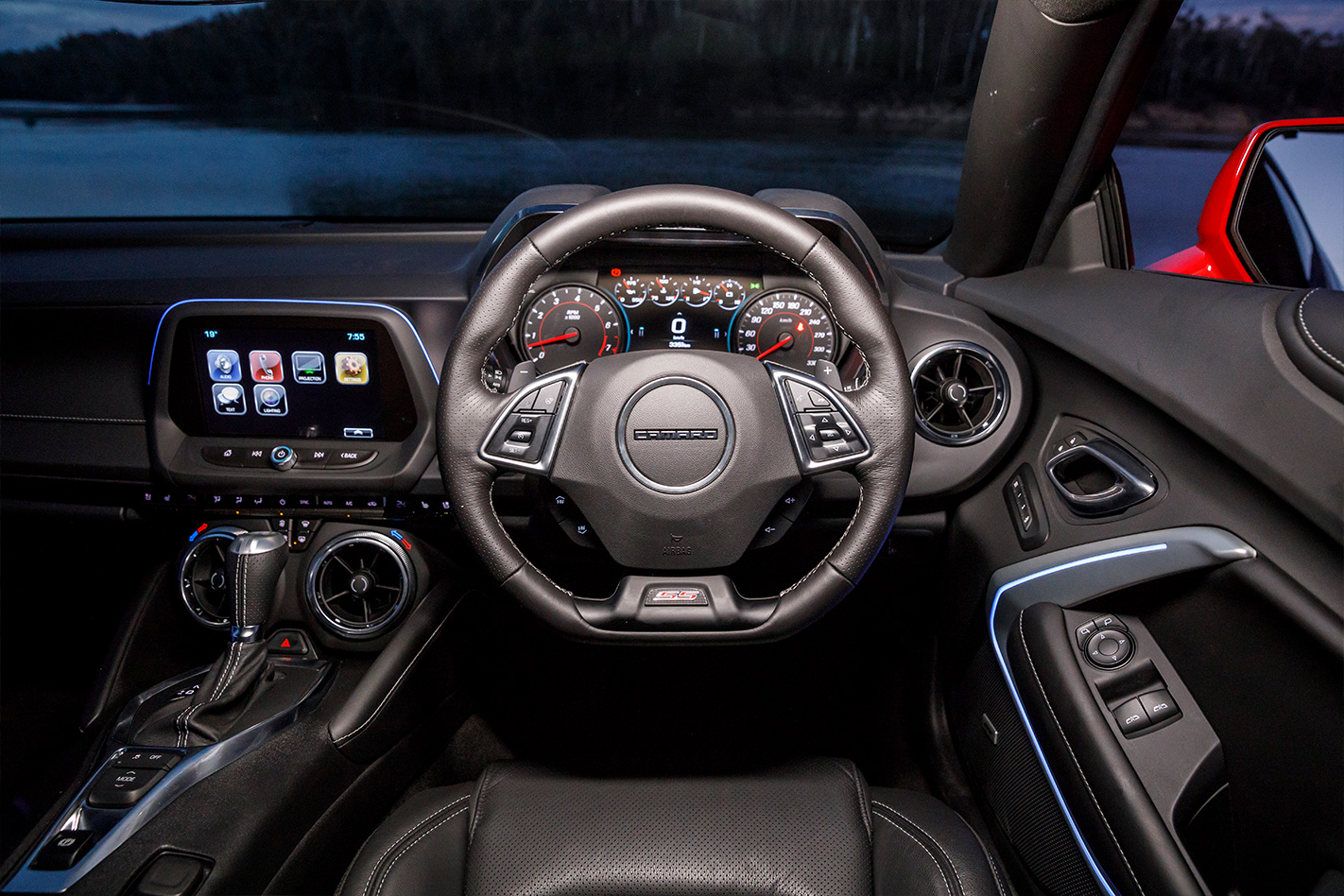
It tops a Mustang GT in terms of offering full power adjustment for both front seats, and standard 20-inch wheels, but nothing that makes any real case for the unfortunate $20K price gulf that separates it from the rival Ford. Let’s move on, because I can’t shake the question marks about the chassis tune. On longer amplitude stuff it shows a reasonable level of damping finesse, but at a cruise on lumpy backroads it can quickly turn choppy and reactive. The fixed-damper tune is a result of Australian cars being sourced from Argentina, where magnetic dampers aren’t offered. Any potential Camaro buyers used to the greater breadth of damping range provided by the likes of HSV’s three-mode GTS will have to accept Camaro’s more singular focus.A COLD wind scuds across the strip at Heathcote, and the clouds out to the west over the ranges look heavy with rain. But the surface is dry, and the cool air temp will help the LT1, even if the three-quarter-filled tank and my 105kg won’t.
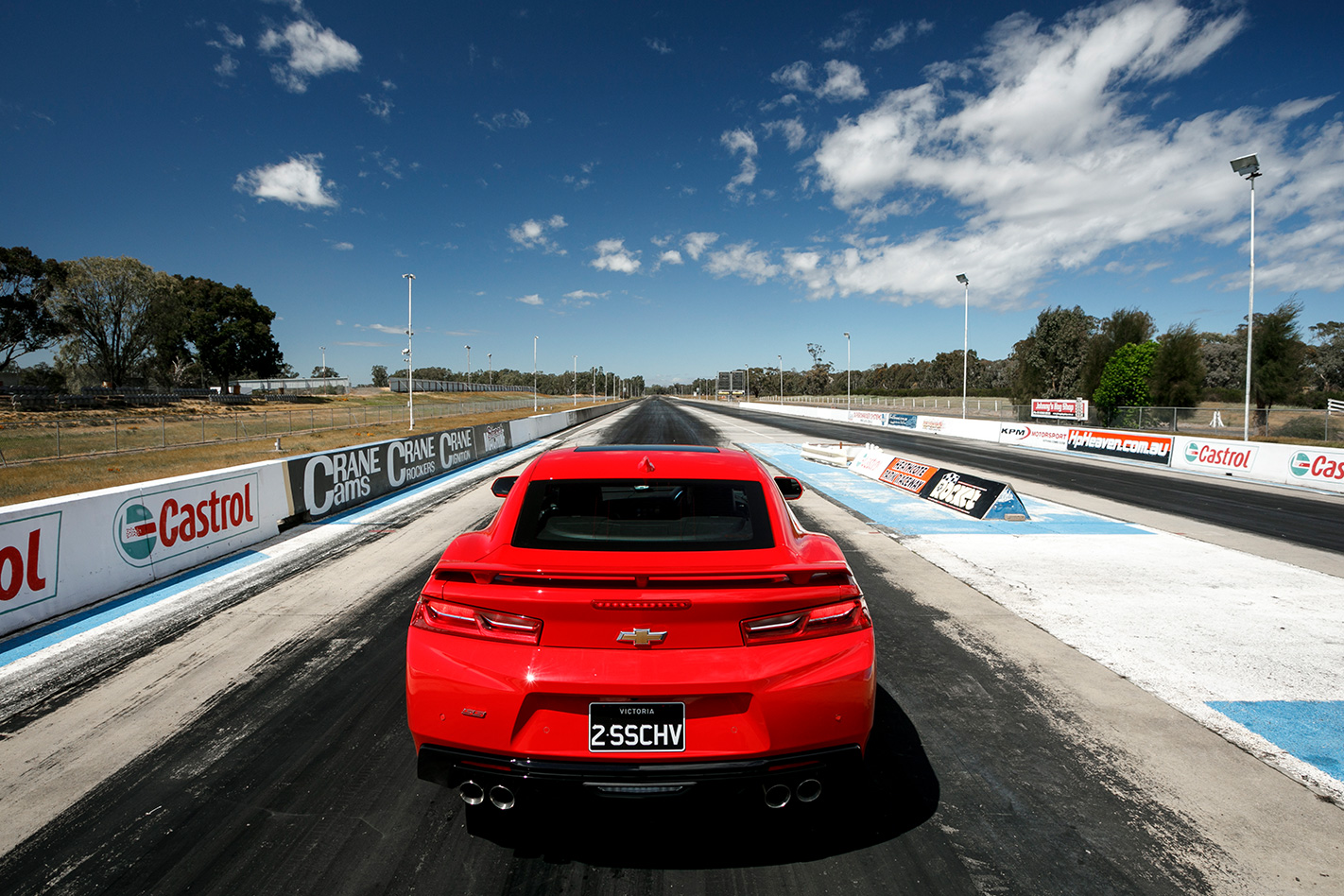
First launch, with ESC on, sees it step away, then bog momentarily as the electronics take over, before the engine comes bellowing back on song, and roars through the mid-range, hitting its real on-cam sweet spot at a bit over 4000rpm. It’s ferocious and rev-hungry as it lunges past 6000rpm, sounding even more crisp and harder than I remember the 340kW LS3 version of this engine architecture. Each upshift comes with a spit of expelled exhaust pressure, like a gunslinger hawking out a wad of chewing tobacco. It’s a thrilling V8, capable of raising the hairs on your neck, not just on the emotive level for what it represents for Team Red, but for the way it hollers as it hurls you down the road.
The first sprint number seems a bit unremarkable at 5.1sec – the claim is 4.4 – but experimenting with launch techniques with the ESC off and balancing the wheelspin manages to shave off a few tenths to pull the number down to 4.9sec, with 12.9sec for 0-400m. For context, we recorded a 5.0sec/13.2s from the 306kW, pre-facelift Mustang, so expect the updated Ford’s additional 33kW to pull the pair of Ameri-straya coupes super close.
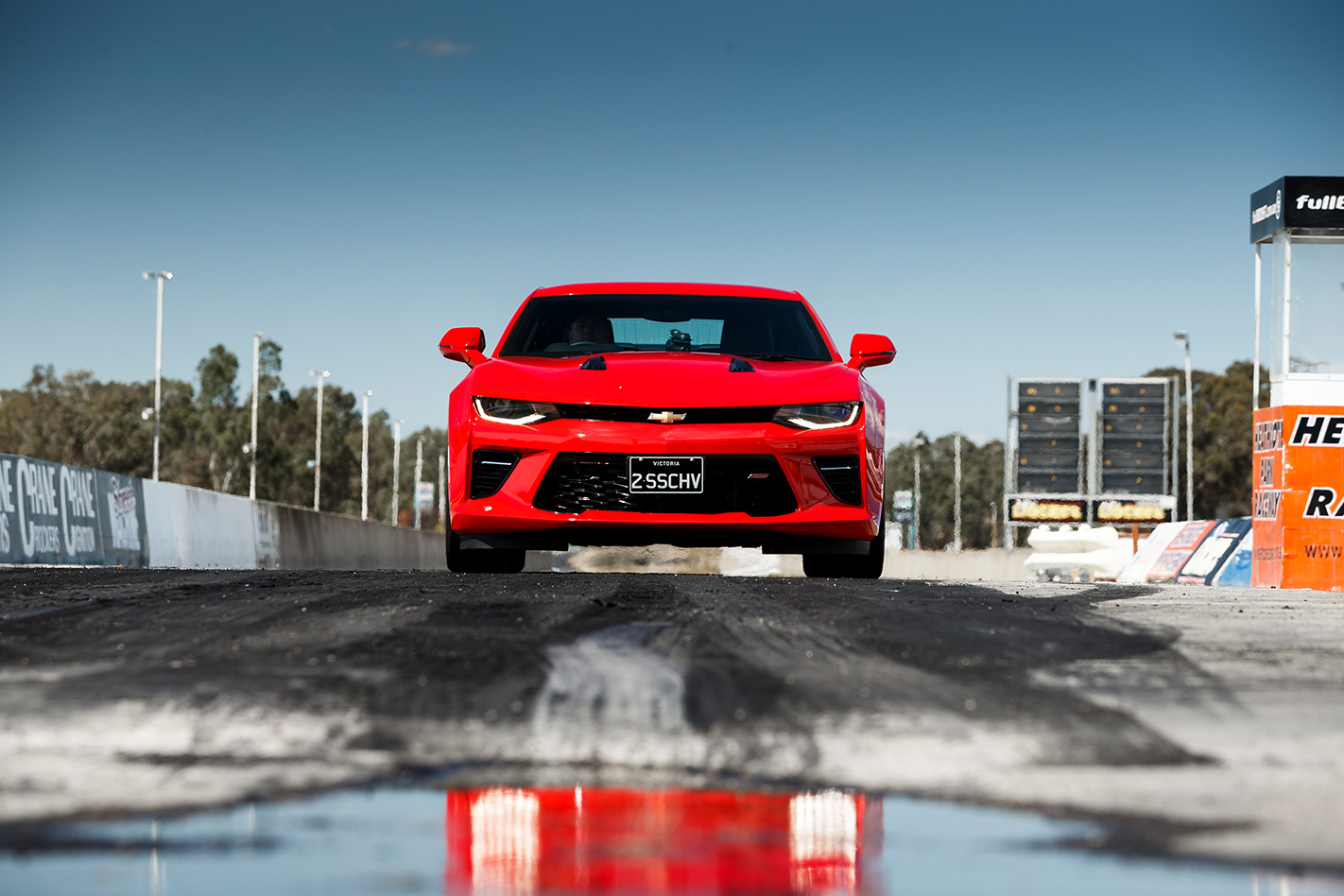
Camaro’s engine edge, if one exists, is likely to come in its torque delivery thanks to the capacity advantage (6.3L v 5.0). Its lazy, lopey character is like relaxing in a hammock when you’re on the schelp, with that brilliant ability to launch straight back into the real meat of the torque curve and pin its ears back when you want to blast past comatose traffic.
The brakes feel powerful, with a strong, progressive bite, hauling the 1710kg car down from around 200km/h at the end of the strip, and the measured number of 100km/h-0 in 36.7m is not bad. But after the stomp test, I’m not inclined to really wail on them; the front rotors, at 345mm, are 22mm smaller than those fitted as standard on the last of the HSV R8 Clubsports.
Our plan is to head to Echuca, a historic trading town on the banks of the Murray and home to the National Holden Motor Museum, where we want to introduce Camaro to some of its illustrious family forebears, and also gauge a reaction from visiting Holden fans. In this warped new world of German Commodores, can they really take to Camaro like it’s part of the Lion pride?
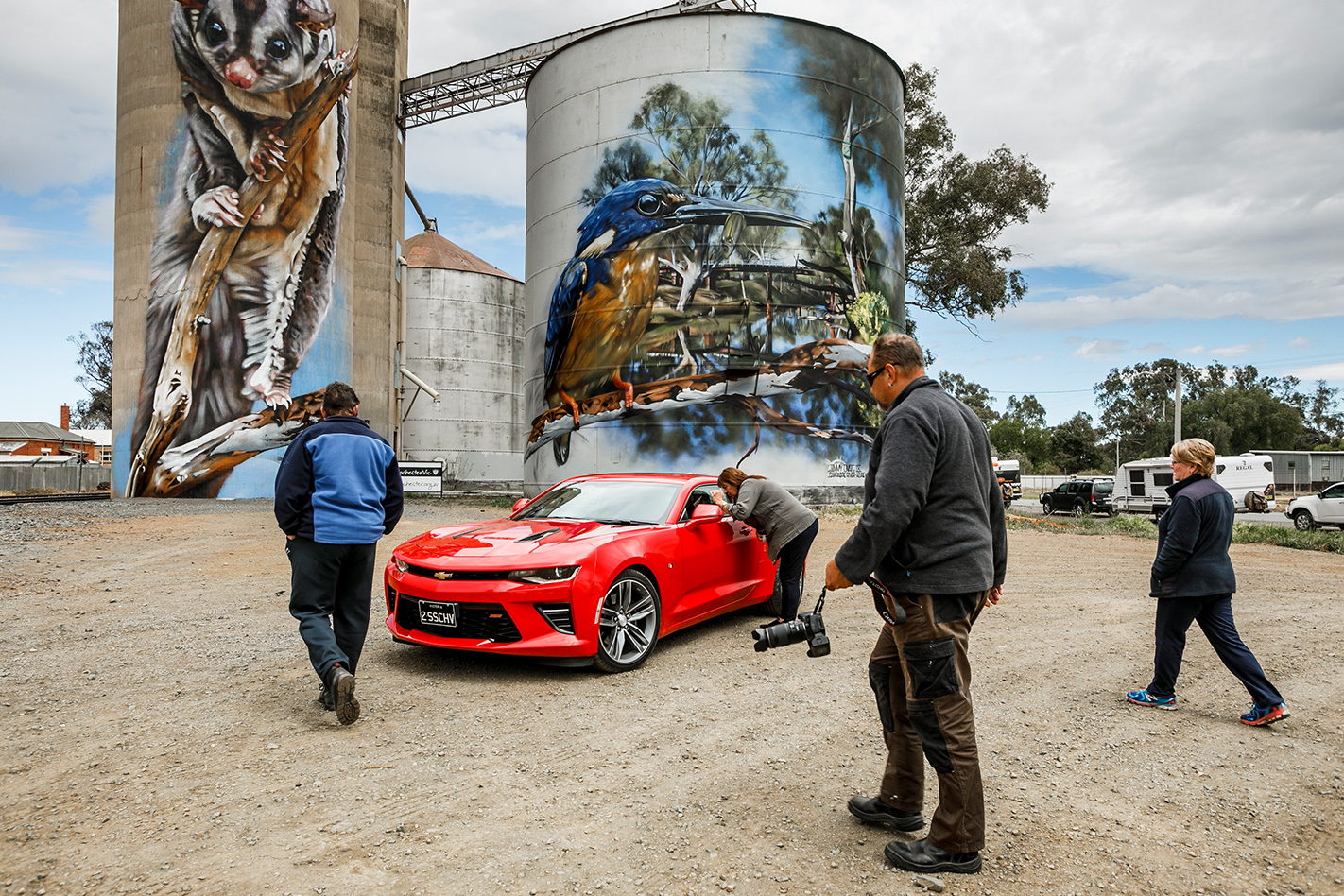
Our first indicator comes in the wheat town of Rochester, 180km north of Melbourne. This place was on the decline until recently, when it became part of the Silo Art Trail. Two massive GrainCorp silos provide the canvas for a pair of stunning murals of a squirrel glider and kingfisher by artist Jimmy Dvate, and as we roll in, there’s a gaggle of tourists snapping photos.
Yet the soaring artwork is no match for a blazing red Camaro and its chest-thumping V8. Instantly the questions start flying: “How much? How fast? Can I sit in it?” As Jacobs composes a shot, a couple of the more selfless ladies tell us they’d be happy to get their tops off and drape themselves over the bonnet – all in the name of art, of course. I gently explain that’s my job, but it’s a very kind offer.
Echuca has a charming and well-preserved historic-town section by the riverbank, but we don’t spend long there. As we pull up to the National Holden Motor Museum, co-owner Mark Galea prowls suspiciously around the Camaro, like a territorial dog deciding if he’ll let the muscular new mutt take a slash on his lawn.
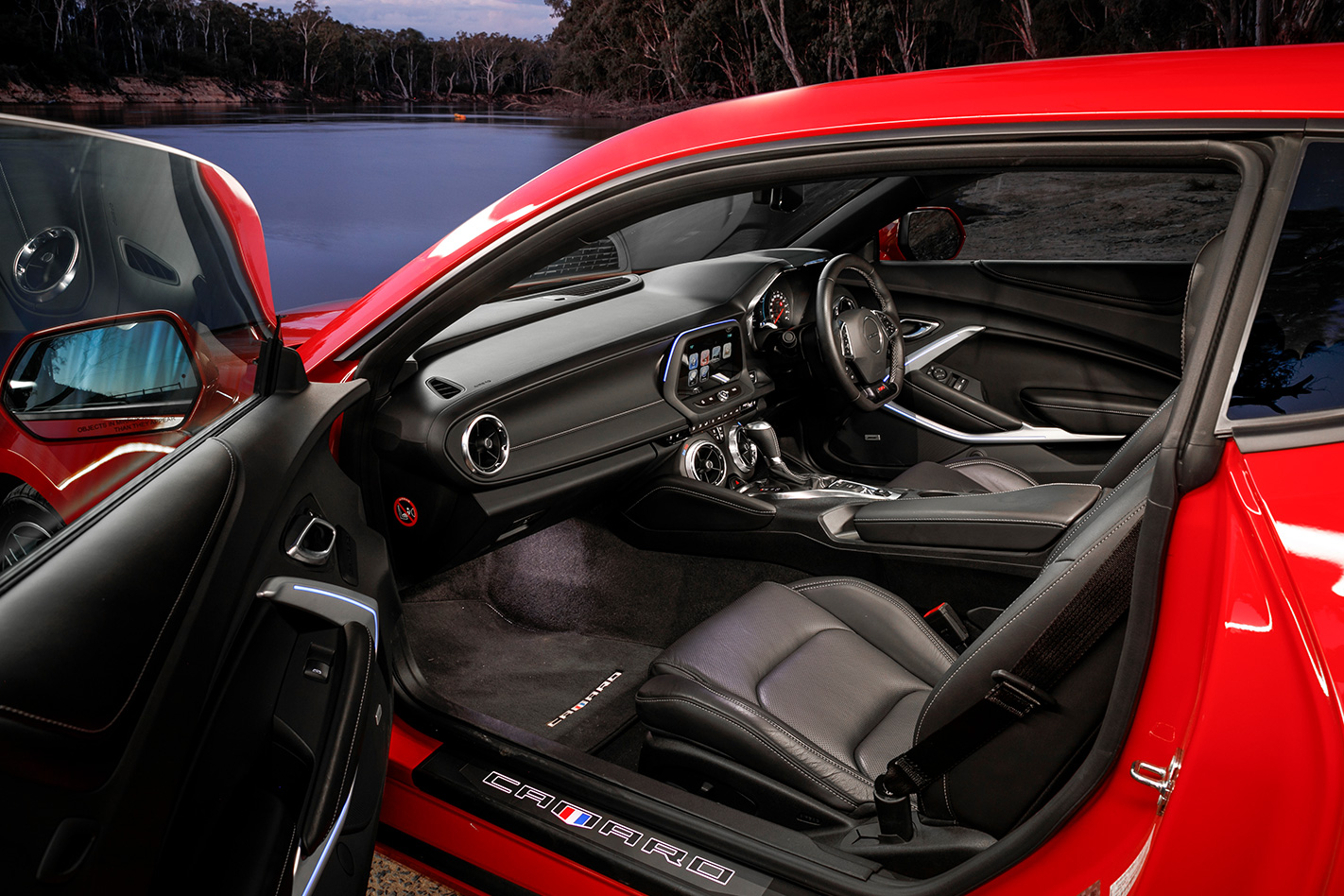
The collection over which Galea presides is properly impressive, with pretty much every significant locally made Holden represented. So could the museum ever create a guest-spot for the likes of Camaro, given that there’s no other way to contemporaneously expand the collection?
“Um, well … but it’s not a Holden,” Galea says glumly. Maybe a quick steer of the Chevy-badged interloper could cheer him up? By the time he’s given it large down a few quiet roads outside of town, he’s definitely thawing. But more importantly, when we return, the junior visitors to the museum are all over the Camaro like picnic ants, ignoring heavyweight drawcards like the HSV W427. Instead, they paw at the American coupe, eager to see its engine, crawl around its interior (while tripping on the ridiculous seatbelt design that impedes them getting in the back) and drink in its Yank uniqueness.
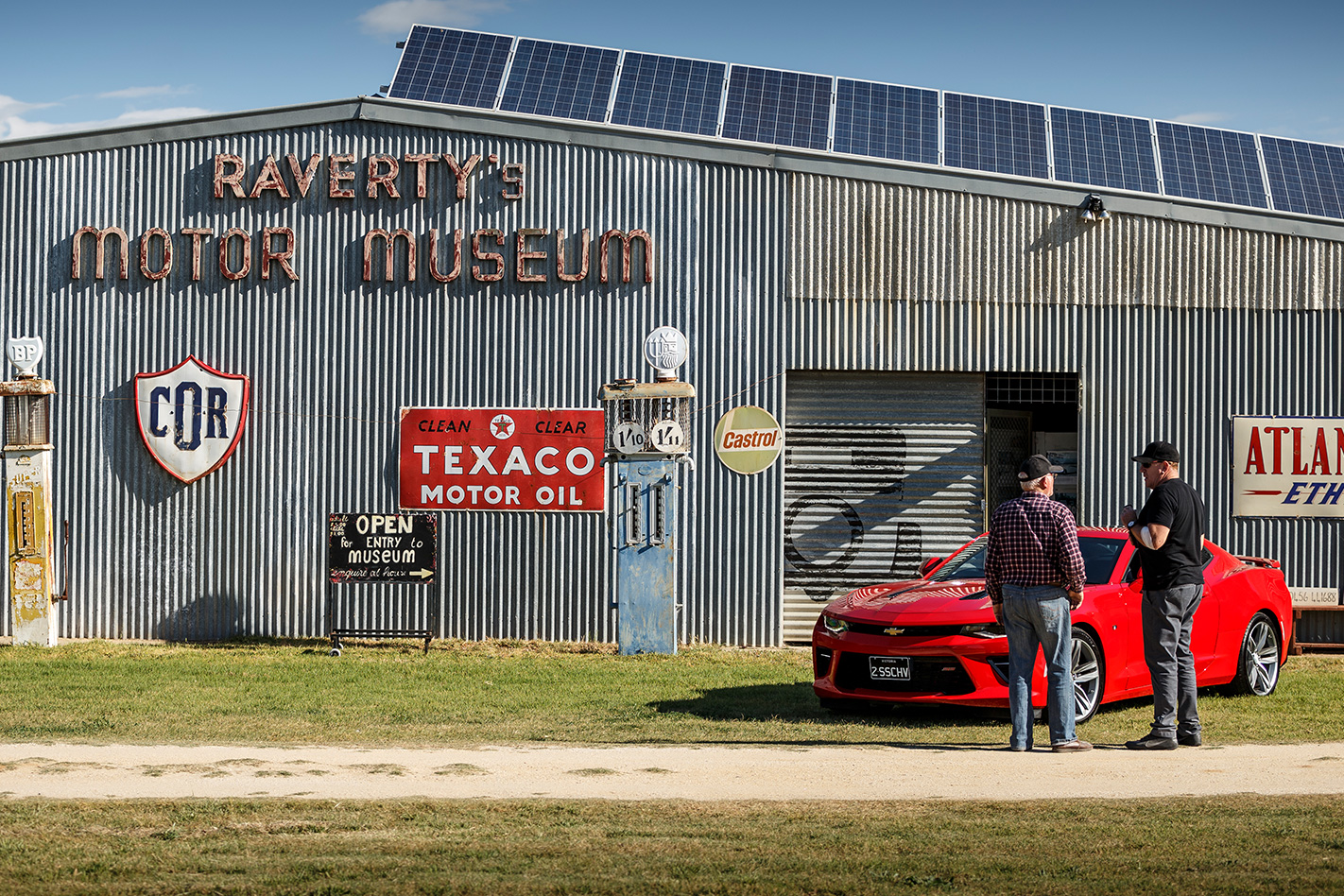
Great, but frankly I’m getting an itchy throttle foot, and enough of this “feelings” stuff on the automotive shrink’s couch. It’s time to find somewhere quiet to give Camaro a proper pasting, and go in search of the athleticism lurking under the sheetmetal.
The wickedly winding section of the Murchison Spur road near Broadford is just the job. Instantly the steering starts to make more sense, at least in its ‘lightest’ setting, which can be separated from the four drive modes by digging into the on-screen menu. (Not sure why this, and the exhaust mode, are located here, rather than bundled with the drive modes on the centre-console.) I’d still prefer even less weight and a bit more nuance, but colleagues tell me they were fine with it, so put it down to personal preference. What’s inarguable is the level of front-end purchase, and how the chassis just seems to get more resolved and feelsome the harder you drive it. “It’s the opposite of the Mustang,” dep-ed Enright tells me later. “The Ford starts to wilt when you’re really into it, whereas the Camaro laps it up.”
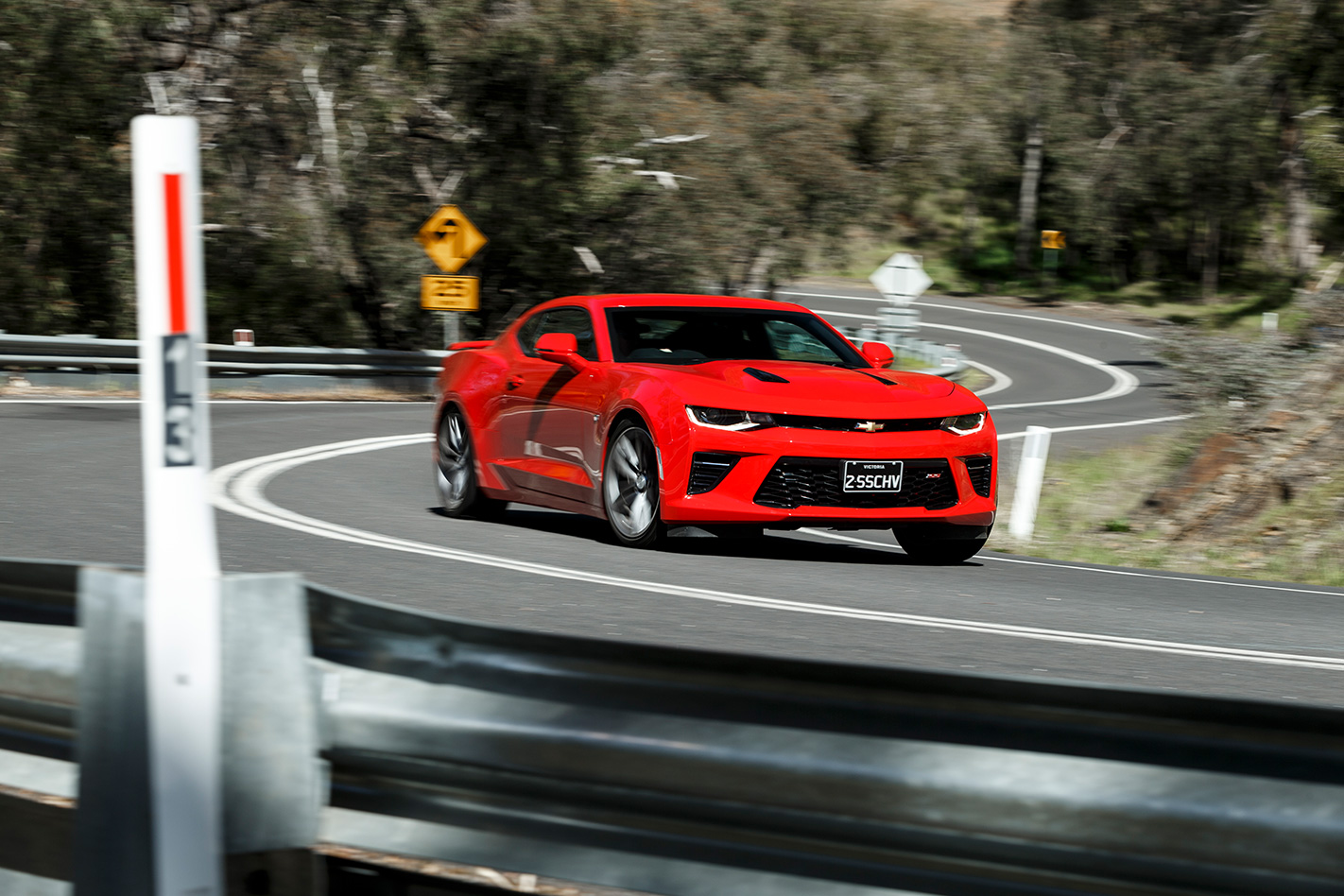
In Track mode, the ESC allows the rear to slide agreeably, and the throttle response is so precise past 4000rpm, you can neatly and easily walk along the tightrope between grip and slip as you pour on the power. Into one fast left-hander near the bottom of the climb, there’s room to pitch it in early, gas hard, and marvel at the resolute body control and beautifully telegraphed yaw from the rear. The sound of that V8 crackles and booms through the green valley, making it worth opening the sunroof. In this moment, it’s easy to fall for Camaro’s powers of seduction. Eventually the stoppers go soft, although not before we’ve had our fill on what is a brilliant but brake-punishing bit of road.
IT’S OBVIOUS the Camaro has real star power, and an almost exotic desirability that make plenty of Holden fans ready to pull it into a tight embrace. What’s the line from that song? “If you can’t be with the one you love, love the one you’re with.” The engine performance and hard-driven dynamics will have owners prepared to park their HSV Commodore memories; even better, for some, it’s not a Mustang.
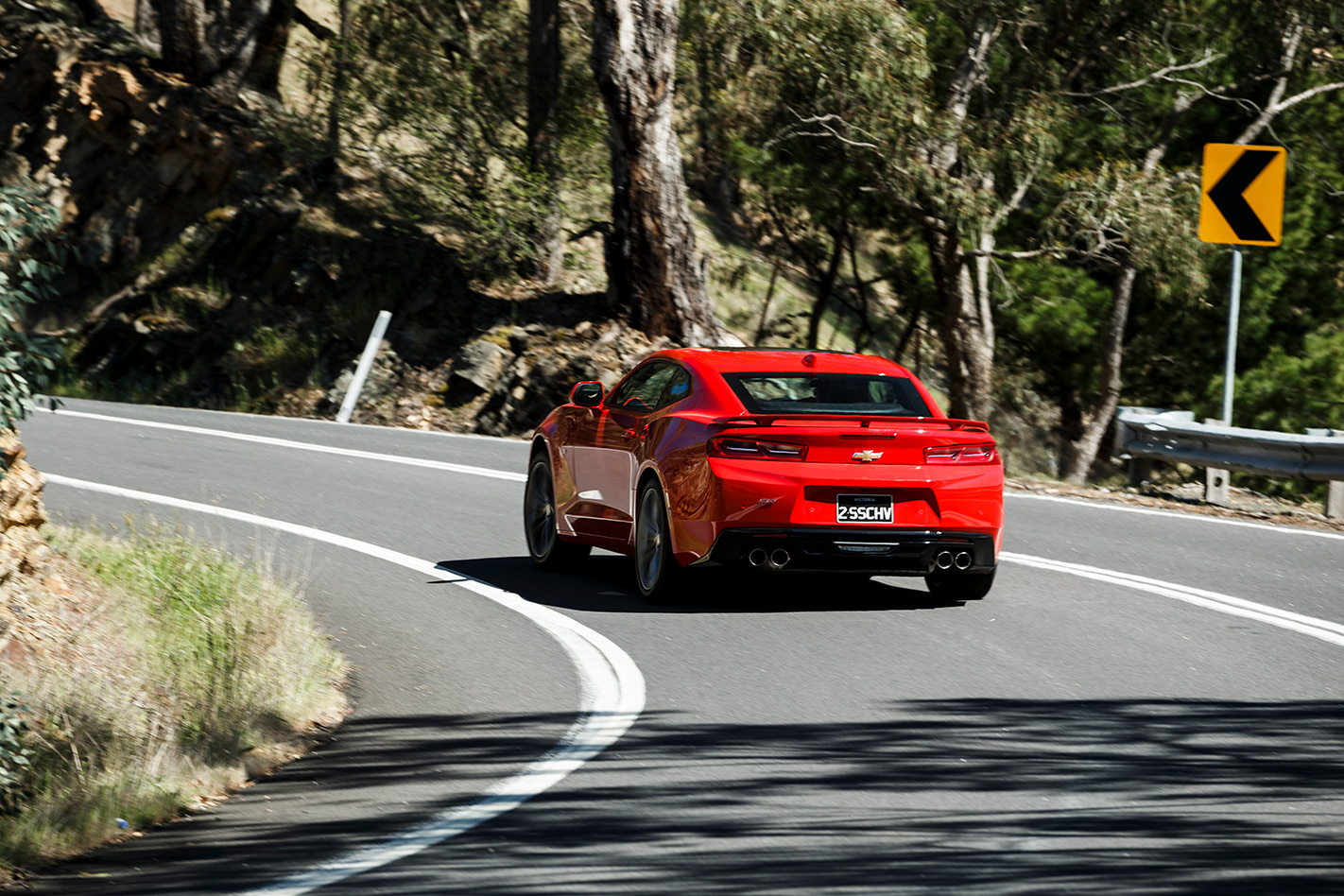
Yet there’s no escaping the flaws that temper its daily usability, like the abysmal rear-three-quarter vision, crap cabin storage and kids-only rear seats. I’m also adamant that it could be an even more complete car with a bit of HSV wand-waving over the damping and EPAS calibration.
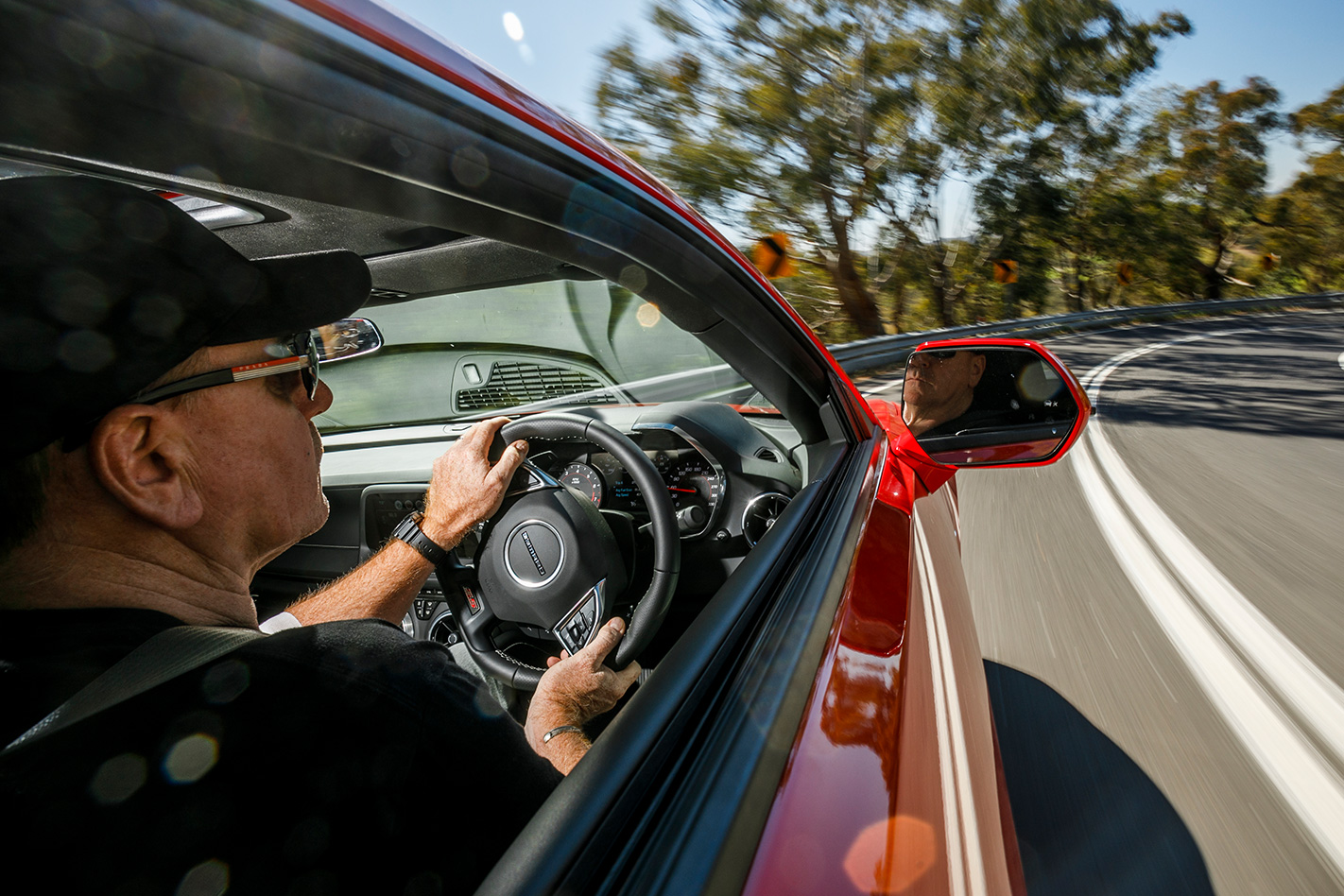
So don’t expect the all-round dynamic polish delivered by the final run of VF Holdens: both the cars that came via Clayton, and the ones that didn’t. We always knew what we had was pretty special, and Camaro is taciturn proof. Maybe we need to accept that to move forward, sometimes you have to take a half-step back, and it’s time to just give a grateful nod of respect to the bow-tied gangsta that now lords over the red end of town.


